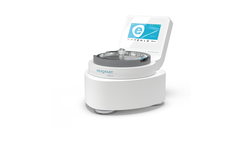Air jet sieve machine
Air jet sieve machine
NEXOPART Sieve shaker and sieve machines: Precision and reproducibility in particle size analysis
Precise and reproducible results are essential in laboratory work – especially in particle size analysis. Sieve shakers and sieve machines play a key role here: these specialized devices standardize the sieving process, ensure consistent sample preparation, and thus enable reliable and reproducible determination of particle size distribution. This not only increases efficiency, but also significantly improves the accuracy of laboratory tests.
Application examples – industries with high demands on particle size analysis
Precise particle size analysis is essential in many industries, including:
- Chemical industry: Influence on reaction speed and product quality in the manufacture of catalysts, pigments, etc.
- Building materials industry: Determination of the strength and workability of concrete through particle analysis of cement, sand, and gravel.
- Pharmaceutical industry: Control of the effectiveness and bioavailability of tablets.
- Food industry: Influence on taste and solubility, e.g., of instant coffee or spice mixtures.
- Environmental industry: For the classification of soil samples or sediments, e.g., in contaminated site investigations.

Your advantages with NEXOPART:
If you have any questions about our sieve shakers and sieve machines or other NEXOPART products, please contact us. We will be happy to help you.
NEXOPART sieve shaker and sieve machines – high quality for precise control
NEXOPART offers a comprehensive range of sieve shakers and sieve machines that cover all laboratory requirements. Our products at a glance:
Classic vibrating sieve shakers for wet and dry sieving (EML series and UWL):
L
2. Measuring range from 20 µm to 125 mm.
3. Example: Analysis of sand grains for building material testing or pharmaceutical powders.
4. Models: EML Pure, EML 200 Premium, EML 200 Premium Remote, EML 315, EML 450, UWL 400.
5. Technical data: 110/ 230 V, 50 - 60 Hz, amplitude control, interval operation.
RO-TAP sieve shaker:
L
2. Measuring range from 20 µm to 125 mm.
3. Example: Quality control of abrasives for wood and metalworking.
4. Recommended in the FEPA standard
5. Models: RX-29, RX-30 und RX-94
6. Technical data: 115/ 230 V, 50/ 60 Hz, with timer function, CE-compliant available with soundproof cabinet
Air jet sieve machine e200 LS:
L
2. Measuring range from 10 µm to 4 mm.
3. Integrated “eControl” software enables user-friendly and precise analysis.
4. Example: Analysis of active pharmaceutical ingredients or fine color pigments.
5. Model: e200 LS
6. Technical data: 90 - 264 V, 50/ 60 Hz, 1500 - 5000 Pa negative pressure, four software packages: LITE, BASIC, ULTIMATE, SECURITY (FDA 21 CFR Part 11 compliant)
Further information about the
e200 LS can be found on our product page.

Your advantages of NEXOPART sieve shaker and sieve machines
- Standardization: Uniform sieving processes reduce sources of error and improve reproducibility.
- Flexibility: Different machine types for different sample types and particle sizes.
- User-friendly: Modern control software facilitates operation and evaluation.
- Quality assurance: Ensuring product quality through precise particle size analysis.
With NEXOPART sieve shakers and sieve machines, you can take your laboratory analyses to a new level of quality. Find out how you can make your research, development and quality assurance more efficient and precise through the targeted use of the right sieve machine.
What are sieve shakers and sieve machines?
L
EML series from NEXOPART – Electromagnetic laboratory machine:
L
Special process: Tap sieving (RO-TAP®)
L
Unlike classic 3D sieving, RO-TAP® moves the sieve tower in a horizontal, elliptical motion. In addition, a tapping impulse is applied to the top of the sieving tower with each rotation. This combination improves separation, especially for materials that are difficult to sieve, and ensures greater precision.
Air jet sieve machine e200 LS – the solution for fine and agglomerating particles:
L
In contrast to sieving with a sieve tower, the process begins with the finest test sieve. The test sieve is closed with a lid and an industrial vacuum cleaner creates negative pressure inside the machine. The suction effect presses the sample material onto the sieve bottom. At the same time, a rotating slot nozzle blows air through the sieve mesh from below. This air movement swirls the sieved material and loosens stuck particles. This allows even heavily agglomerated particles to be reliably separated.
Advantages over manual sieving:
L
1. Standardized and reproducible results
2. Significant time savings in everyday laboratory work
3. Higher measurement accuracy through controlled processes
4. Possibility of flexible use of different sieving methods
However, if you do not want to do without manual sieving, you are guaranteed to find the right test sieve for you
on our shop page.
FAQ
Why are sieve shakers and sieve machines indispensable for laboratories and quality control?
L
Manual sieving is subjective and can vary depending on the operator. Sieve shakers and sieve machines ensure consistent sample handling through standardized movements, which significantly increases the reproducibility of results.
2. Time savings and efficiency:
Automated sieving processes significantly reduce the time required. While manual sieving can take several minutes to hours, sieve shakers and sieve machines complete this task in a fraction of the time – with greater precision.
3. Improved accuracy:
The uniform and controlled movement of the sieves separates particles more efficiently. This leads to a more accurate determination of particle size distribution, which is essential for many scientific questions.
4. Versatility and flexibility:
Sieve shaker and sieve machines are compatible with different sieve sizes and types. This allows them to be adapted to a wide variety of sample types and requirements – from fine powders to coarse granules.
5. Documentation and reproducibility:
Modern sieve shakers and sieve machines often feature digital controls and interfaces that enable precise documentation of sieving parameters. This supports quality assurance and facilitates compliance with laboratory standards and norms.
How do sieve shakers and sieve machines improve laboratory testing?
L
Sieve shakers and sieve machines perform the sieving process using fixed parameters such as amplitude, frequency, and duration. This ensures that sample handling remains reproducible and independent of the operator. This standardization ensures valid and comparable results over time and between laboratories.
2. Minimization of sample loss and contamination:
Manual sieving carries risks such as sample loss and contamination from environmental influences. Sieve shakers and sieve machines operate in closed systems that minimize sample contact with the environment. They are made of easy-to-clean materials, which prevents cross-contamination – particularly important in pharmaceutical and chemical analysis.
3. Precise particle size analysis:
Particle size distribution is a key parameter in many sciences. It influences the physical, chemical, and mechanical properties of materials. Sieve shakers and sieve machines separate particles precisely according to size, thus creating the basis for precise analyses. The use of standardized sieves (e.g., according to ISO 3310-1) and controlled sieve movement ensure that the results are highly accurate and internationally comparable.
4. Optimization of process parameters
In research and development, you can specifically influence material properties. Particle size distribution helps to optimize grinding degree, mixing ratios and drying times. Sieve shakers and sieve machines deliver this data quickly and reliably. This allows you to shorten development cycles and increase product quality.
How do I find the right sieve shaker or sieve machine?
L
Depending on the sample quantity and requirements for particle size distribution resolution.
2. Type of sieve movement:
Horizontal, elliptical, or circular – each movement has specific advantages for different sample types.
3. Frequency and amplitude:
Adjustable parameters allow adaptation to different materials.
4. Degree of automation:
From simple devices to fully automatic systems with digital control and documentation.
5. Cleaning and maintenance::
Machines with easy-to-clean components and robust design are an advantage in everyday laboratory work.
6. Compliance with standards:
Devices that comply with the relevant standards (e.g., ASTM, ISO) support adherence to quality standards.
Practical tips for using sieve shakers and sieve machines:
- Clean laboratory environment: Only tested, calibrated sieve shakers and sieve machines should be used
- Sample preparation: Avoid samples that are too small/too large, avoid overfilling the sieves, choose the correct division method based on the “quartering and coning” model, e.g., by using sample dividers
- For vibrating sieve shakers, clamp the sieve tower evenly on both sides: If the clamping nuts come loose during sieving, stop sieving, reconnect the sieves, and clamp the nuts tightly again + observe the minimum sieve tower height (min. 3 analytical sieves + sieve pan).
- Observe the order of the mesh sizes: From coarse to fine.
- Correct setting of the sieve shaker: Set a higher amplitude (1.2 - 2 mm) for coarse materials and a lower amplitude (0.5 - 1.0 mm) for powders and fine materials.
- Sieve selection: Use sieves with suitable mesh sizes according to the expected particle sizes.
- Parameter optimization: Adjust the frequency, amplitude and sieve time to the material properties in order to achieve optimum sieving results.
- Regular maintenance: Clean and check sieve shakers and sieve machines regularly to ensure consistent performance.
- Automatic test sieve cleaning: The NEXOPART e200 LS air jet sieve machine has an “automatic test sieve cleaning” option in its menu selection. Insert the analytical sieve upside down, start the sieving process and brush the sieve bottom with a brush. This loosens particles, which are then discarded without entering the environment – ideal for materials that are hazardous to health.
- Documentation: Document all parameters and results to ensure traceability and quality assurance – this saves time and standardizes processes.
NEXOPART offers comprehensive service, repair, and maintenance for your products. Find out more on our service page.






